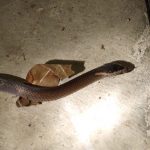GOLDEN-CROWNED SNAKE
The Golden-Crowned Snake: A Glimpse into Australia’s Enigmatic Reptile
In the lush rainforests and moist woodlands of eastern Australia, a slender, nocturnal predator prowls under the cover of night. This is the Golden-Crowned Snake (Cacophis squamulosus), a species that embodies the delicate balance of Australia’s diverse ecosystems.
A Nocturnal Hunter
As dusk settles, the golden-crowned snake emerges from its daytime refuge beneath rocks, logs, or the protective blanket of leaf litter. Its keen senses guide it through the underbrush, where it hunts small lizards, such as skinks, and occasionally frogs. This diet is supplemented by the occasional egg, adding variety to its nocturnal meals.
A Distinctive Appearance
The golden-crowned snake’s appearance is both striking and distinctive:
Dorsal Surface: A gradient of greyish-brown to dark brown scales, providing camouflage among the forest floor’s shadows.
Ventral Surface: A vibrant orange to pink hue, adorned with a midline of black spots, reminiscent of a sunset filtering through the trees.
Crown Marking: A pale yellow-brown stripe begins at the snout, sweeping back along both sides of the head and trailing down the neck, not connecting at the back, creating a unique crown-like appearance.
This coloration not only adds to its beauty but also serves as a warning to potential predators of its venomous nature.
Habitat and Distribution
The golden-crowned snake is predominantly found in the eastern regions of Australia, from Canberra in the south to Cairns in the north. Its preferred habitats include:
Rainforests: Thriving in the humid, sheltered environments of mountain slopes.
Moist Woodlands: Occasionally venturing into suburban gardens near waterways, where lush ground cover provides ample shelter.
This adaptability allows the species to inhabit a range of environments, from dense forests to the edges of human settlements.
Behaviour and Venom
While the golden-crowned snake is mildly venomous, it is generally non-aggressive. When threatened, it may:
Bluff Display: Rearing into an S-shape to display its bright orange ventral pigmentation.
Mock Bites: Striking with a closed mouth as a defensive tactic.
Bites from larger individuals can cause local pain and swelling, but are unlikely to be dangerous. As with any snake bite, it’s important to seek medical attention promptly.
Conservation Status
The golden-crowned snake is currently listed as “Least Concern” by the International Union for Conservation of Nature (IUCN). However, habitat loss due to urban development and agriculture poses potential threats to its populations. Conservation efforts focusing on habitat preservation are essential to ensure the continued survival of this unique species.
The golden-crowned snake is a testament to the rich biodiversity of Australia’s ecosystems. Its nocturnal habits, distinctive appearance, and role in controlling small reptile populations highlight its importance in maintaining ecological balance. By understanding and appreciating such species, we can foster a deeper connection to the natural world and support efforts to preserve it for future generations.


